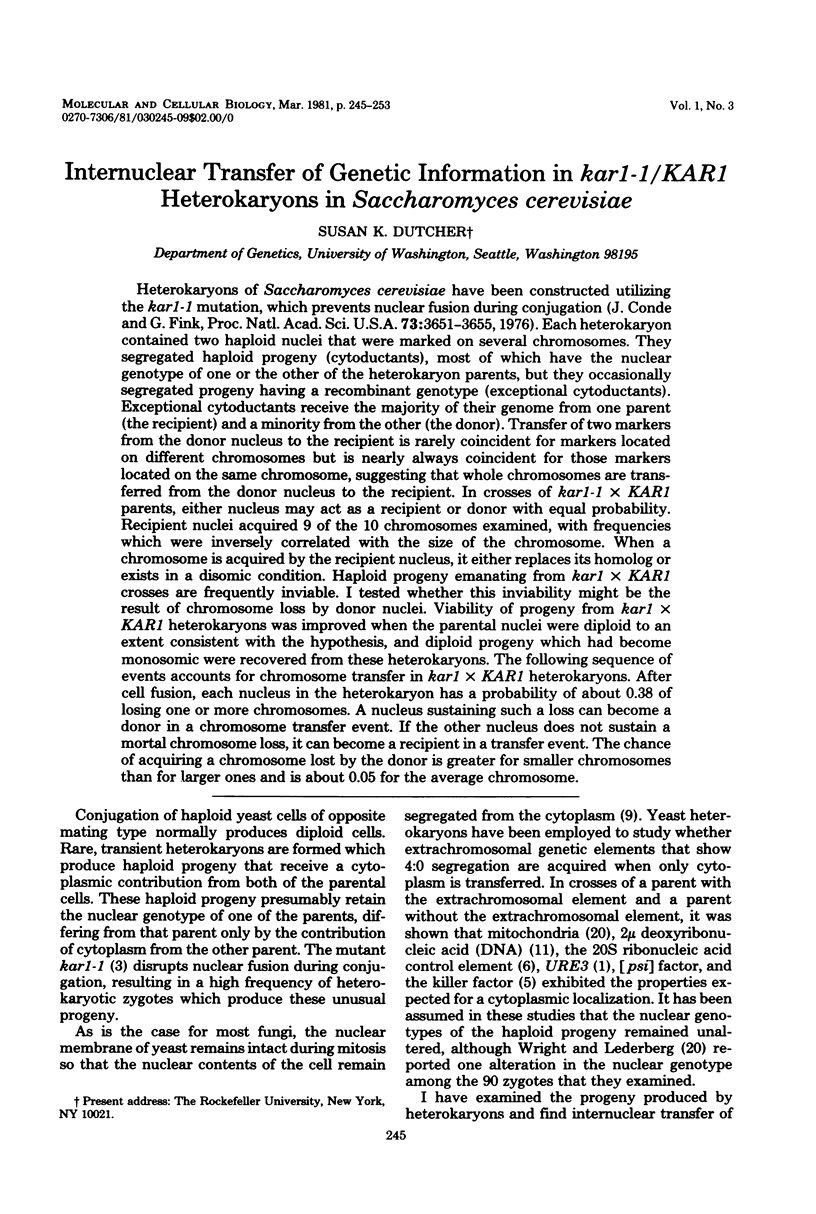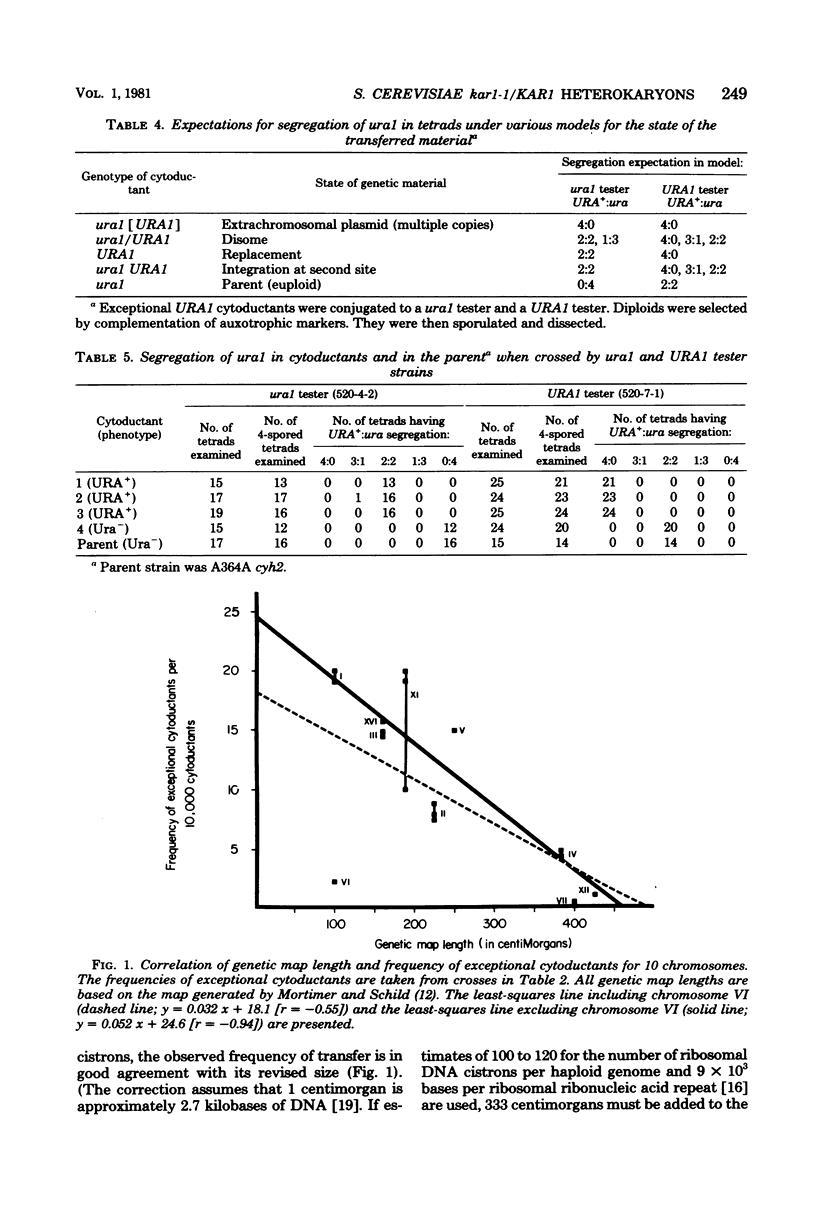Abstract
Heterokaryons of Saccharomyces cerevisiae have been constructed utilizing the kar1-1 mutation, which prevents nuclear fusion during conjugation (J. Conde and G. Fink, Proc. Natl. Acad. Sci. U.S.A. 73:3651-3655, 1976). Each heterokaryon contained two haploid nuclei that were marked on several chromosomes. They segregated haploid progeny (cytoductants), most of which have the nuclear genotype of one or the other of the heterokaryon parents, but they occasionally segregated progeny having a recombinant genotype (exceptional cytoductants). Exceptional cytoductants receive the majority of their genome from one parent (the recipient) and a minority from the other (the donor). Transfer of two markers from the donor nucleus to the recipient is rarely coincident for markers located on different chromosomes but is nearly always coincident for those markers located on the same chromosome, suggesting that whole chromosomes are transferred from the donor nucleus to the recipient. In crosses of kar1-1 X KAR1 parents, either nucleus may act as a recipient or donor with equal probability. Recipient nuclei acquired 9 of the 10 chromosomes examined, with frequencies which were inversely correlated with the size of the chromosome. When a chromosome is acquired by the recipient nucleus, it either replaces its homolog or exists in a disomic condition. Haploid progeny emanating from kar1 X KAR1 crosses are frequently inviable. I tested whether this inviability might be the result of chromosome loss by donor nuclei. Viability of progeny from kar1 X KAR1 heterokaryons was improved when the parental nuclei were diploid to an extent consistent with the hypothesis, and diploid progeny which had become monosomic were recovered from these heterokaryons. The following sequence of events accounts for chromosome transfer in kar1 X KAR1 heterokaryons. After cell fusion, each nucleus in the heterokaryon has a probability of about 0.38 of losing one or more chromosomes. A nucleus sustaining such a loss can become a donor in a chromosome transfer event. If the other nucleus does not sustain a mortal chromosome loss, it can become a recipient in a transfer event. The chance of acquiring a chromosome lost by the donor is greater for smaller chromosomes than for larger ones and is about 0.05 for the average chromosome.
Full text
PDF








Selected References
These references are in PubMed. This may not be the complete list of references from this article.
- Aigle M., Lacroute F. Genetical aspects of [URE3], a non-mitochondrial, cytoplasmically inherited mutation in yeast. Mol Gen Genet. 1975;136(4):327–335. doi: 10.1007/BF00341717. [DOI] [PubMed] [Google Scholar]
- Bruenn J., Mortimer R. K. Isolation of monosomics in yeast. J Bacteriol. 1970 May;102(2):548–551. doi: 10.1128/jb.102.2.548-551.1970. [DOI] [PMC free article] [PubMed] [Google Scholar]
- Conde J., Fink G. R. A mutant of Saccharomyces cerevisiae defective for nuclear fusion. Proc Natl Acad Sci U S A. 1976 Oct;73(10):3651–3655. doi: 10.1073/pnas.73.10.3651. [DOI] [PMC free article] [PubMed] [Google Scholar]
- Davidow L. S., Goetsch L., Byers B. Preferential Occurrence of Nonsister Spores in Two-Spored Asci of SACCHAROMYCES CEREVISIAE: Evidence for Regulation of Spore-Wall Formation by the Spindle Pole Body. Genetics. 1980 Mar;94(3):581–595. doi: 10.1093/genetics/94.3.581. [DOI] [PMC free article] [PubMed] [Google Scholar]
- Garvik B., Haber J. E. New cytoplasmic genetic element that controls 20S RNA synthesis during sporulation in yeast. J Bacteriol. 1978 Apr;134(1):261–269. doi: 10.1128/jb.134.1.261-269.1978. [DOI] [PMC free article] [PubMed] [Google Scholar]
- Hartwell L. H. Macromolecule synthesis in temperature-sensitive mutants of yeast. J Bacteriol. 1967 May;93(5):1662–1670. doi: 10.1128/jb.93.5.1662-1670.1967. [DOI] [PMC free article] [PubMed] [Google Scholar]
- Klar A. J. Mating-Type Functions for Meiosis and Sporulation in Yeast Act through Cytoplasm. Genetics. 1980 Mar;94(3):597–605. doi: 10.1093/genetics/94.3.597. [DOI] [PMC free article] [PubMed] [Google Scholar]
- Kubai D. F. The evolution of the mitotic spindle. Int Rev Cytol. 1975;43:167–227. doi: 10.1016/s0074-7696(08)60069-8. [DOI] [PubMed] [Google Scholar]
- Liras P., McCusker J., Mascioli S., Haber J. E. Characterization of a mutation in yeast causing nonrandom chromosome loss during mitosis. Genetics. 1978 Apr;88(4 Pt 1):651–671. [PMC free article] [PubMed] [Google Scholar]
- Livingston D. M. Inheritance of the 2 micrometer m DNA plasmid from Saccharomyces. Genetics. 1977 May;86(1):73–84. doi: 10.1093/genetics/86.1.73. [DOI] [PMC free article] [PubMed] [Google Scholar]
- Mortimer R. K., Schild D. Genetic map of Saccharomyces cerevisiae. Microbiol Rev. 1980 Dec;44(4):519–571. doi: 10.1128/mr.44.4.519-571.1980. [DOI] [PMC free article] [PubMed] [Google Scholar]
- PONTECORVO G., KAFER E. Genetic analysis based on mitotic recombination. Adv Genet. 1958;9:71–104. [PubMed] [Google Scholar]
- Petes T. D. Unequal meiotic recombination within tandem arrays of yeast ribosomal DNA genes. Cell. 1980 Mar;19(3):765–774. doi: 10.1016/s0092-8674(80)80052-3. [DOI] [PubMed] [Google Scholar]
- Petes T. D. Yeast ribosomal DNA genes are located on chromosome XII. Proc Natl Acad Sci U S A. 1979 Jan;76(1):410–414. doi: 10.1073/pnas.76.1.410. [DOI] [PMC free article] [PubMed] [Google Scholar]
- Philippsen P., Thomas M., Kramer R. A., Davis R. W. Unique arrangement of coding sequences for 5 S, 5.8 S, 18 S and 25 S ribosomal RNA in Saccharomyces cerevisiae as determined by R-loop and hybridization analysis. J Mol Biol. 1978 Aug 15;123(3):387–404. doi: 10.1016/0022-2836(78)90086-4. [DOI] [PubMed] [Google Scholar]
- Sena E. P., Radin D. N., Welch J., Fogel S. Synchronous mating in yeasts. Methods Cell Biol. 1975;11:71–88. doi: 10.1016/s0091-679x(08)60317-9. [DOI] [PubMed] [Google Scholar]
- Strathern J. N., Newlon C. S., Herskowitz I., Hicks J. B. Isolation of a circular derivative of yeast chromosome III: implications for the mechanism of mating type interconversion. Cell. 1979 Oct;18(2):309–319. doi: 10.1016/0092-8674(79)90050-3. [DOI] [PubMed] [Google Scholar]
- Wright R. E., Lederberg J. EXTRANUCLEAR TRANSMISSION IN YEAST HETEROKARYONS. Proc Natl Acad Sci U S A. 1957 Oct 15;43(10):919–923. doi: 10.1073/pnas.43.10.919. [DOI] [PMC free article] [PubMed] [Google Scholar]


